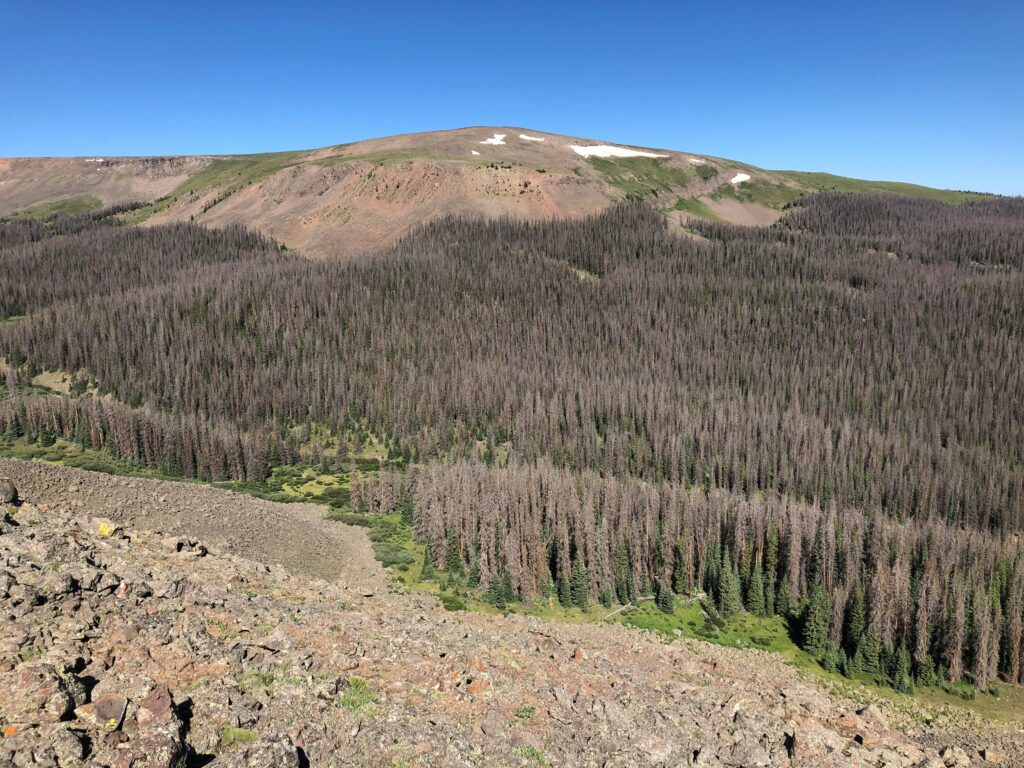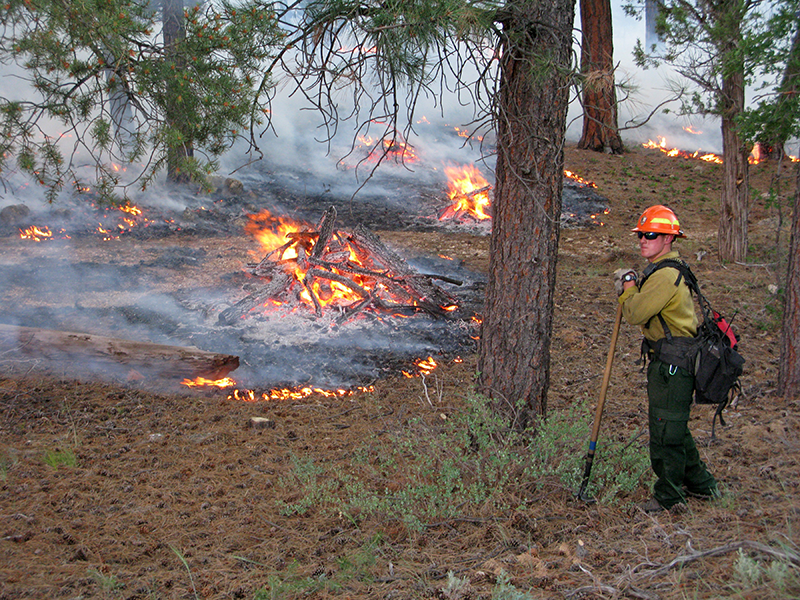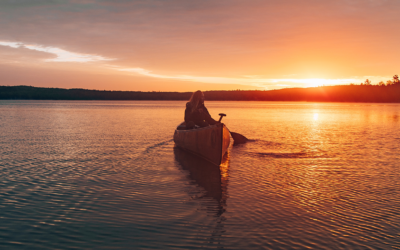View of the Sierra Nevada from the Granite Mountain Wilderness, California. Photo credit: Tobias Nickel.
A Plea for a Standard Definition of “Natural” in Wilderness Stewardship
Stewardship
December 2021 | Volume 27, Number 3
The Wilderness Act of 1964 mandates that an area of wilderness is “protected and managed so as to preserve its natural conditions” (Section 2c). Based on this statutory language, agency guidance documents have recognized natural conditions as one of five qualities of wilderness character (National Park Service 2014; Landres et al. 2015; BLM 2020; Landres et al. 2021). Indeed, every year, wilderness managers approve and implement management interventions inside designated wilderness with the justification that these actions improve (or prevent degradation of) the natural quality of wilderness character (Liebermann et al. 2018).
However, managing for “natural conditions” is increasingly becoming a Sisyphean undertaking in the Age of the Anthropocene, a time characterized by intensifying human domination of biophysical environments and processes (Crutzen 2002; Steffen et al. 2007). Human-caused climate change and the coupling of human and ecological systems render it more and more difficult to sift apart human and natural causes of environmental change. In disrupting the carbon cycle, humans are not only changing the chemical composition of the atmosphere, but we are also, at least indirectly, altering Earth’s biosphere, hydrosphere, and lithosphere. As Bill McKibben (1989) observes in The End of Nature, “For the first time human beings had become so large that they altered everything around us.” He continues: “Our appetites and habits and desires could now be read in every cubic meter of air, in every increment on the thermometer.” Human influence is ubiquitous, and everything is modified by us to some degree. Anthropogenic forces have become so intertwined and entangled with natural systems that we have effectively ended nature as an independent force on Earth.

Figure 1 – Large swaths of forests in the Powderhorn Wilderness affected by the ongoing spruce beetle epidemic. What does it mean to manage for “natural conditions” in the Anthropocene? Photo by Tobias Nickel.
In the face of these shifting environmental conditions, the question then arises whether it is desirable or even feasible to sustain natural conditions, especially when that means expending ever greater amounts of energy and using heavy-handed human control to resist change. In “The Untrammeled Wild and Wilderness Character in the Anthropocene,” Roger Kaye (2018) succinctly explains this challenge. He writes, “Wilderness areas will continue to become less and less natural. Attempting to maintain their natural conditions or components will require increasing levels of intervention, manipulation, and ecological restoration.”
As a result, land managers charged with the mandate of preserving wilderness character are increasingly confronted with a stewardship dilemma of whether wilderness ecosystems should be left wild and untrammeled or, paradoxically, be manipulated toward a more natural state (Cole 2001). In “Preserving the Wildness of Wilderness in the Anthropocene,” published in the last issue of this journal, Kaye (2021) captures this dilemma in the following question: “Should we strive to maintain natural conditions, that is, the products of evolutionary creativity at our point in time, or should we perpetuate that creative process itself, wildness?”
As human domination of ecological systems and processes intensifies both in extent and magnitude, new pressures to trammel and calls for active ecosystem management to sustain sensitive native species are arising. Under these circumstances, wilderness mangers will increasingly be faced with difficult decisions of whether, when, where, and how to intervene in ecosystem processes. However, in attempting to preserve natural conditions, Kaye and others are concerned that wilderness managers may be sacrificing one of the principal reasons why wilderness areas were protected to begin with: as places where nonhuman nature is self-willed, autonomous, and not subjugated to human designs and purposes. Given these pressures and competing values over what wilderness is and should be, Landres et al. (2020) predict, “The combination of climate change with other landscape stressors is driving ecological restoration to be one of the single most important, challenging, and potentially litigious wilderness stewardship issues.”
In light of intensifying anthropogenic pressures and accompanying management dilemmas, I am concerned that the federal land management agencies tasked with the responsibility of stewarding our National Wilderness Preservation System have not developed further guidance or consensus on a definition of “natural conditions.” As Cole and Yung (2010) note, “Naturalness is inscribed in most protected area policies but is rarely, if ever, defined with any specificity.” Unlike the words “untrammeled” and “wilderness character,” which have been discussed and defined at length, the term “natural” remains elusive.
The result of this ambiguity and lack of standard terminology is disagreement and controversy that is fueled by a lack of transparency and defensibility in decision-making. Under current agency guidelines, several different and often conflicting management actions can be justified by invoking the ambiguous natural quality of wilderness character. As Landres et al. (2020) point out, “Decisions allowing or denying restoration in wilderness are currently made on a case-by-case basis in the context of scientific uncertainty, ambiguous law and policy, and competing values.” In this context, how should managers manage for “natural conditions” as mandated by the Wilderness Act? How do we define, monitor, and assess natural conditions? How do we know when natural conditions are deteriorating and when management action is needed? How do we know when ecological restoration projects have accomplished their goals?
When the Wilderness Act was passed, the meaning of “natural” likely was obvious and uncontroversial. However, as I have tried to show, this is no longer the case in the Anthropocene. In fact, the very future of how we steward the National Wilderness Preservation System may, at least in part, hinge on how we define “natural.”
The fundamental problem is that the term “nature” has several different uses, and confusion can result when it is used without stipulating its precise meaning. The influential Leopold Report of 1963, which set out principles that helped guide park and wilderness stewardship in the United States for decades, stated that “above all other policies, the maintenance of naturalness should prevail” (Leopold et al. 1963). The Leopold report largely (and infamously) framed naturalness in terms of historical fidelity: “As a primary goal, we would recommend that the biotic association within each park be maintained, or where necessary recreated, as nearly as possible in the condition that prevailed when the area was first visited by white man. A national park should represent a vignette of primitive America” (Leopold et al. 1963).
In the 21st century, however, this policy direction of preserving historical conditions has become increasingly problematic. Directly rebuking the Leopold Report, Landres et al. (2015) write, “The Natural Quality [of wilderness character] should not be used to recreate historical conditions from an arbitrary point in time (such as pre-European settlement or the date of wilderness designation).” Ecological systems are in a constant state of flux, and it is impossible to to freeze-frame them.

Figure 2 – Pile burning in ponderosa forests of Grand Canyon National Park. Fire management represents one of the greatest challenges for wilderness managers in the 21st century and compels us to think deeply about the problem of managing for naturalness. Photo by Michael Quinn/National Park Service.
In addition to an increased scientific understanding of nature’s inherently dynamic processes, alternative and indigenous views of the human-nature relationship critique past notions of “natural.” Our increased anthropological understanding of the influence that Native peoples had on previously assumed “pristine” landscapes calls into question the very premise of human separateness. In his essay, “The Trouble with Wilderness, or, Getting Back to the Wrong Nature,” William Cronon (1995) traces the intellectual history of “the myth of the wilderness as ‘virgin,’ uninhabited land.” Cronon argues that the ideal of wilderness (i.e., self-willed, pristine, independent nature) originated in Europe with romanticist thinkers and was subsequently projected by European settlers onto the American landscape. However, as Potawatomi scientist and author Robin Wall Kimmerer (2000) explains, “The presettlement landscape was often intensively managed by its original inhabitants, so what we viewed as pristine was the product of human intervention.” In other words, the independent, pristine wilderness, the loss of which McKibben (1989) mourns in his book The End of Nature, never really existed in the first place. Wilderness, construed as a domain where nature is fully independent and self-willed, is only a “cultural invention,” “the reflection of our own unexamined longings and desires” (Cronon 1995).
In brief, we face the challenge of applying more nuance and thought to the term “natural,” the meaning of which most of us previously took for granted. In Beyond Naturalness, Cole and Yung (2010) even go as far as to argue that the “the concept of naturalness does not provide sufficient guidance for future park and wilderness stewardship.” While Cole and Yung may be correct in suggesting that the term “natural” has outlived its usefulness, the concept of naturalness is not likely to disappear from legislation and federal policy frameworks any time soon. Therefore, I believe that we must make a collective effort to make sense of and define what we mean by natural conditions in the context of wilderness stewardship.
To provide a starting point for this difficult conversation ahead, I would like to offer some preliminary thoughts and approaches on how we might go about defining naturalness. I currently see four principal options for defining “natural” for purposes of managing units of the National Wilderness Preservation System. The first is to collapse the distinction between the natural and undeveloped qualities of wilderness character. There always has been a great emphasis on the apparent naturalness of wilderness in the Wilderness Act. Section 2(c) says wilderness “generally appears to have been affected primarily by the forces of nature, with the imprint of man’s work substantially unnoticeable” (emphases added). In identifying areas suitable for wilderness designation, the federal land management agencies have often interpreted apparent naturalness to refer to whether an area looks natural to the average visitor who is not familiar with the biological composition of natural ecosystems versus human-affected ecosystems. From this perspective, human-made features (i.e., developments) are generally considered to degrade the naturalness of an area. This focus on developments in evaluating natural conditions might lend credibility to an approach that seeks to merge the natural quality with the undeveloped quality of wilderness character.
Another, opposing option would be to stress the ecological integrity of an area as a measure of its naturalness. Under this approach, the science of ecology would be heavily relied upon to assess whether an area is natural according to agreed-upon indices and measurements. Such a definition of natural would go far beyond apparent naturalness as viewed by the average visitor and solicit the expertise of scientists and land managers in evaluating whether an area is natural. This approach would likely support an interventionist approach to wilderness management that emphasizes ecological integrity, resiliency, or ecosystem health as management goals (although this approach still would require balancing those goals with the other qualities of wilderness character).
A third option would be to define naturalness in terms of historical fidelity, as I have already discussed. In a modified and contemporary version of the Leopold Report (1963), such an approach would prioritize the preservation of ecosystem composition and processes within historic ranges of variation. Historical fidelity differs from ecological integrity in that it emphasizes the preservation of specific biological structures, processes, and assemblages that existed at some period in time (determining the exact dates of that period is, of course, a difficult and value-laden exercise). For example, proponents of ecological integrity may accept extirpation of individual species, as long as the system as a whole maintains its overall resilience and functionality. By contrast, the loss of a species that has “historically” been present in an area would be unacceptable from the viewpoint of historical fidelity. Naturalness defined as historical fidelity would likely result in the highest degree of intervention in wilderness ecosystems to maintain “natural conditions.”
A fourth option would define “natural” to mean the opposite of modern human civilization. While we have already established that in the Anthropocene no place on Earth is completely unaffected by human influence, that does not mean that all places are equally dominated by human activity. In this view, naturalness would describe the relative autonomy or independence of wilderness ecosystems from the effects of modern civilization. From this perspective, the further an organism or ecosystem is removed from the chain of human causality, the more “natural” it is. While difficult to measure, this approach would likely merge the untrammeled and natural qualities of wilderness character on some level.
There is always the option of developing a definition that represents a composite of the above approaches. I am confident others will also formulate additional definitions that I have not presented here. In the end, I fully recognize the difficulty and far-reaching consequences of defining “natural conditions” in the context of the Wilderness Act of 1964. However, I believe it is ultimately in our own best interest to develop defensible methods and definitions that will hold up to public scrutiny. Rather than making up makeshift definitions of naturalness when pressed to make management decisions, let us attempt to systematically steward our enduring wilderness with a consistent and thoughtful understanding of what we mean by “natural conditions.” Therefore, it is my humble plea that the federal land management agencies and their partners begin an inclusive and deliberate process to develop a definition of the term “natural” for the purpose of stewarding the units included in the National Wilderness Preservation System. To be clear, I am not taking a stance on whether management interventions to protect natural conditions inside wilderness are appropriate or not. Rather, my goal with this plea is to stimulate conversation and exchange of ideas on this important topic that we all deeply care about, hopefully steering us toward a positive evolution of the wilderness ideal.
About the Authors
TOBIAS NICKEL is a wilderness trails steward with the Colorado Mountain Club and a wilderness stewardship and outreach manager with the Center for Public Lands at Western Colorado University; email: tobias.nickel@gmail.com.
References
Bureau of Land Management (BLM). 2020. Measuring attributes of wilderness character: BLM implementation guide version 2.0. https://wilderness.net/practitioners/toolboxes/wilderness-character/, accessed May 21, 2021.
Cole, D. N. 2001. Management dilemmas that will shape wilderness in the 21st century. Journal of Forestry 99(1): 4–8.
Cole, D. N., and L. Yung, eds. 2010. Beyond Naturalness: Rethinking Park and Wilderness Stewardship in an Era of Rapid Change. Washington, DC: Island Press.
Cronon, W. 1995. The trouble with wilderness; or, getting back to the wrong nature. In Uncommon Ground: Toward Reinventing Nature, ed. W. Cronon (pp. 69–90). New York: W. W. Norton & Company.
Crutzen, P. J. 2002. Geology of mankind. Nature 41: 23. https://doi.org/10.1038/415023a, accessed May 21, 2021.
Kaye, R. 2018. The untrammeled wild and wilderness character in the Anthropocene. International Journal of Wilderness 24(1): 8–16.
Kaye, R. 2021. Preserving the wildness of wilderness in the Anthropocene. International Journal of Wilderness 27(2): 12–19.
Kimmerer, R. W. 2000. Native knowledge for native ecosystems. Journal of Forestry 98(8): 4–9.
Landres, P., C. Barns, S. Boutcher, T. Devine, P. Dratch, A. Lindholm L. Merigliano N. Roeper, and E. Simpson. 2015. Keeping It Wild 2: An Updated Interagency Strategy to Monitor Trends in Wilderness Character across the National Wilderness Preservation System. General Technical Report RMRS-GTR-340. Fort Collins, CO: US Department of Agriculture, Forest Service, Rocky Mountain Research Station. https://wilderness.net/practitioners/toolboxes/wilderness-character/, accessed May 21, 2021.
Landres, P., S. Boutcher, E. Mejicano, and E. Sandeno, eds. 2021. Wilderness Character Monitoring Technical Guide. General Technical Report RMRS-GTR-426. Fort Collins, CO: US Department of Agriculture, Forest Service, Rocky Mountain Research Station. https://www.fs.usda.gov/treesearch/pubs/61747, accessed May 17, 2021.
Landres, P., B. A. Hahn, E. Biber, and D. T. Spencer. 2020. Protected area stewardship in the Anthropocene: Integrating science, law, and ethics to evaluate proposals for ecological restoration in wilderness. Restoration Ecology 28(2): 315–327.
Leopold, A. S., S. A. Cain, C. M. Cottam, I. N. Gabrielson, and T. Kimball. 1963. Study of wildlife problems in national parks: Wildlife management in national parks. In Transactions of the North American Wildlife and Natural Resources Conference, ed. J. B. Trefethen. Washington, DC: Wildlife Management Institute (28): 28–45.
Lieberman, L. A., B. Hahn, and P. Landres. 2018. Manipulating the wild: A survey of restoration and management interventions in U.S. wilderness. Restoration Ecology 26(5): 900–908.
McKibben, B. 1989/2006. The End of Nature. New York: Random House.
National Park Service (NPS). 2014. Keeping It Wild in the National Park Service: A User Guide to Integrating Wilderness Character into Park Planning, Management, and Monitoring. WASO 909/121797. Lakewood, CO: National Park Service.
Steffen, W., P. J. Crutzen, and J. R. McNeill. 2007. The Anthropocene: Are humans now overwhelming the great forces of nature? Ambio 36(8): 614–621.
Read Next
December 2021
In this issue of IJW, we remember George Stankey and his contributions to wilderness research and stewardship. Mark Anderson provides a synthesis of recent findings on carbon storage in old growth forests. Rosemary Evans examines prescribed burning in Britain’s moorlands. And Tobias Nickel presents a call for a standard definition of “Natural” in wilderness stewardship.
Crises of Use
As we transition to a post-pandemic society, demand for transformational, restorative, and education experiences in nature will not recede. Nature has demonstrated its diverse benefits to a greater constituency these past months, and we as advocates, scientists, and managers need to embrace the challenge that comes with a larger audience.
George Stankey: Mentor, Colleague, Friend
George Stankey was a critical thinker who saw the big picture and could work across disciplinary boundaries.



